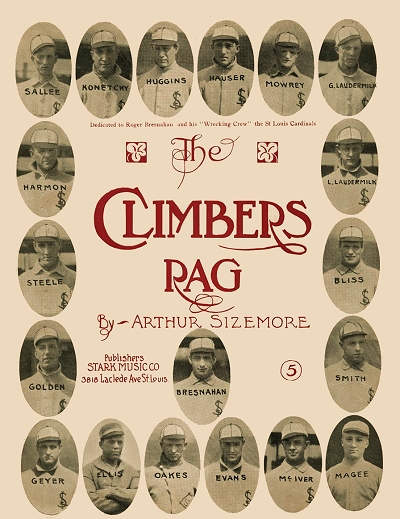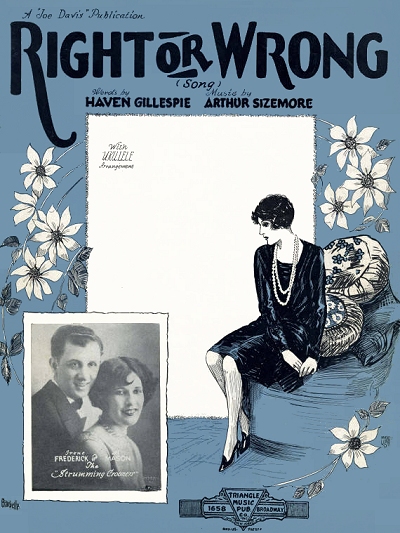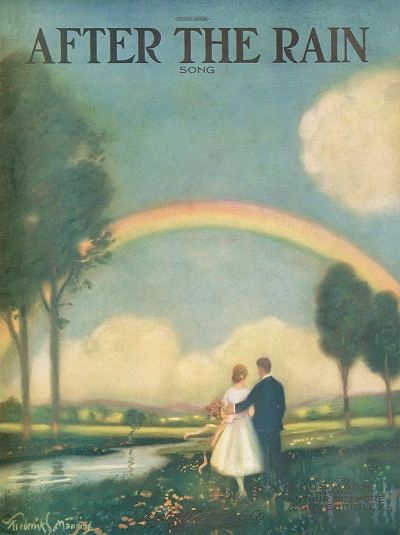Considering how mildly prolific a composer Arthur Sizemore was, it is unusual that so little is known about him, and virtually nothing at all about his older brother Logan Willis Sizemore. What information that could be captured from public records and articles is included here as a reference to Arthur, with mention of Logan, putting in perspective their place in ragtime and popular music.
Arthur and Logan were born to Kentucky native turned Illinois farmer John Calvin Sizemore and his wife Jane Elizabeth Wing. Other siblings included Anna Bell (8/1864) and Martha W. "Mattie" (10/1866), both born in Kentucky, and Augustus Henry (12/15/1868), Albertis Monroe (5/10/1871-5/9/1872), Mary Alice "Mollie" (5/7/1873), Lela Ellen (6/22/1875) and Cora Dell "Carey" (10/27/1877), all born in Williamson County, Illinois. The 1880 census showed the Sizemore family located in Williamson County, about 70 miles southeast of Saint Louis, Missouri. Logan came along on July 19, 1884, followed by Arthur on February 5, 1891. Both were born in Williamson County, in Carterville. Jane passed away in 1891 less than six months after Arthur's birth, leaving John a widower and the children without a mother. Little is known about their upbringing or musical training. As of the 1900 census Mary, Logan and Arthur were living with their father in Bainbridge, Illinois, around 40 miles northwest of Springfield. A granddaughter named Myrtle, possibly born to Henry, had joined the family in 1899.
It is unclear what musical training either Arthur or Logan had over the subsequent decade. However, by 1910, both had published a rag. Logan's only known publication, Scizzor Bill  from 1909, may have come second, since it was "dedicated to my brother composer, Arthur Sizemore." This implies that Art had either already published something, or at least had composed a piece or two. Published in Chicago by Victor Kremer, Scizzor Bill is very indicative of Midwest Folk Ragtime, lacking some sophistication, but retaining a certain charm. There is a probability that Art may have arranged or notated it as well. Arthur's first known contribution, also in 1909, was the rag Blue Blazes also issued by the largely rag-centric house of Kremer. It shows a good level of inventiveness, particularly for an 18-year-old, and promised of good things to come.
from 1909, may have come second, since it was "dedicated to my brother composer, Arthur Sizemore." This implies that Art had either already published something, or at least had composed a piece or two. Published in Chicago by Victor Kremer, Scizzor Bill is very indicative of Midwest Folk Ragtime, lacking some sophistication, but retaining a certain charm. There is a probability that Art may have arranged or notated it as well. Arthur's first known contribution, also in 1909, was the rag Blue Blazes also issued by the largely rag-centric house of Kremer. It shows a good level of inventiveness, particularly for an 18-year-old, and promised of good things to come.
 from 1909, may have come second, since it was "dedicated to my brother composer, Arthur Sizemore." This implies that Art had either already published something, or at least had composed a piece or two. Published in Chicago by Victor Kremer, Scizzor Bill is very indicative of Midwest Folk Ragtime, lacking some sophistication, but retaining a certain charm. There is a probability that Art may have arranged or notated it as well. Arthur's first known contribution, also in 1909, was the rag Blue Blazes also issued by the largely rag-centric house of Kremer. It shows a good level of inventiveness, particularly for an 18-year-old, and promised of good things to come.
from 1909, may have come second, since it was "dedicated to my brother composer, Arthur Sizemore." This implies that Art had either already published something, or at least had composed a piece or two. Published in Chicago by Victor Kremer, Scizzor Bill is very indicative of Midwest Folk Ragtime, lacking some sophistication, but retaining a certain charm. There is a probability that Art may have arranged or notated it as well. Arthur's first known contribution, also in 1909, was the rag Blue Blazes also issued by the largely rag-centric house of Kremer. It shows a good level of inventiveness, particularly for an 18-year-old, and promised of good things to come.The following year Art composed a Latin-tinged piece, The Spanish Glide. At the time of the 1910 enumeration, Arthur was still living with his parents, now in Marion, Illinois, listed as a home farm laborer and not a musican. Logan had left the nest, and was working in Dallas, Texas as a theater musician. Two of Arthur's best known rags appeared in 1911. While Oak Leaf Rag was self-published, The Climbers Rag, dedicated to and featuring pictures of the St. Louis Cardinals, had the distinction of appearing under the imprint of John Stark, who had also published Scott Joplin, Joseph Lamb and James Scott. Given the number of remaining copies, it was at least a moderate seller. Other than a rag that is listed but not confirmed, Moppin' Up Rag, and only a handful of works would appear through 1918. On August 31, 1915, he was married to Olga Larsen in eastern Minnesota. She was a native of that state and the daughter of of Danish immigrants.
Arthur's 1917 draft record shows that he was still married and recently had a child. He was working as a pianist for (approximate spelling) Abe Bagidon at California and Division, next to Humboldt Park. Logan filled out his draft card in Chicago during the last draft call in September of 1918, showing him working as an actor, and also as employed by the Chicago branch of publisher Ted Snyder's Song Shop. From this point on, Logan is difficult to trace until his death on February 4, 1944, in Chicago. He is known to have cut at least one piano roll, a 1907 song titled Have a Smile, for the U.S. Music Roll Company in Chicago around 1918. While Logan did not compose any more, he may have spent many years as an itinerant musician playing in movie houses or small dives.
He is known to have cut at least one piano roll, a 1907 song titled Have a Smile, for the U.S. Music Roll Company in Chicago around 1918. While Logan did not compose any more, he may have spent many years as an itinerant musician playing in movie houses or small dives.
 He is known to have cut at least one piano roll, a 1907 song titled Have a Smile, for the U.S. Music Roll Company in Chicago around 1918. While Logan did not compose any more, he may have spent many years as an itinerant musician playing in movie houses or small dives.
He is known to have cut at least one piano roll, a 1907 song titled Have a Smile, for the U.S. Music Roll Company in Chicago around 1918. While Logan did not compose any more, he may have spent many years as an itinerant musician playing in movie houses or small dives.In 1919, two more of what would be many Sizemore songs wer published; Mississippi Shore with the well-known Illinois native Egbert Van Alstyne and Jail House Blues with frequent collaborator W. Earthman Farrell. Over the next decade, Art would contribute both music and lyrics to a number of songs, sharing credit with a variety of Chicago area writers, many who became well-known names in ragtime and popular song. He also cut a few piano rolls near the end of the decade, including at least a couple for the QRS Piano Roll Company.
As of 1920, known as a competent performer but not so fully established as a composer, Art was listed in Chicago in the census as a piano player, now with two children in the home, Virginia (8/12/1916) and Margaret (2/3/1918). It was in 1921 that he really started on his track with popular songs. One of the first came that same year when Arthur, bandleader Paul Biese, and lyricist Haven Gillespie issued a tune that would eventually become a musical sensation. Right or Wrong had been recorded several times in the 1920s and early 1930s. A 1929 recording by Emmett Miller and the Georgia Crackers did moderately well. However, it was a version with just the chorus that was laid down by singer Bob Wills in 1936, based in part on Miller's take, that turned it into a Country Western swing musical standard that is still performed regularly well into the 21st century.
In 1923 Art opened his own publishing firm in Chicago with his friend and co-composer Guy Shrigley, but it was a short-lived enterprise, folding within two years. A few of of his songs had threaded themes spread over the decade. After the Rain from 1922 was joined by Before the Rain in 1928. A couple of Art's better known songs include Moonlight and You from 1924, and By the Light of the Stars from 1925. The comic song Too Tired from 1923 gained company with So Tired in 1927 and So Comfy in 1929. So Tired was recorded as I'm So Tired of Livin' All Alone by singer Gene Austin with altered lyrics, but became somewhat of a radio hit in 1928. In addition to his songs being heard on records and the radio in the latter part of the 1920s, Sizemore also occasionally appeared on local Chicago stations with local orchestras, including on WDAP (now WGN) and WCFL. Throughout the mid-to-late 1920s he appeared with his own Serenaders in various Illinois venues, including the Madrid Ballroom in Waukegan.
So Tired was recorded as I'm So Tired of Livin' All Alone by singer Gene Austin with altered lyrics, but became somewhat of a radio hit in 1928. In addition to his songs being heard on records and the radio in the latter part of the 1920s, Sizemore also occasionally appeared on local Chicago stations with local orchestras, including on WDAP (now WGN) and WCFL. Throughout the mid-to-late 1920s he appeared with his own Serenaders in various Illinois venues, including the Madrid Ballroom in Waukegan.
 So Tired was recorded as I'm So Tired of Livin' All Alone by singer Gene Austin with altered lyrics, but became somewhat of a radio hit in 1928. In addition to his songs being heard on records and the radio in the latter part of the 1920s, Sizemore also occasionally appeared on local Chicago stations with local orchestras, including on WDAP (now WGN) and WCFL. Throughout the mid-to-late 1920s he appeared with his own Serenaders in various Illinois venues, including the Madrid Ballroom in Waukegan.
So Tired was recorded as I'm So Tired of Livin' All Alone by singer Gene Austin with altered lyrics, but became somewhat of a radio hit in 1928. In addition to his songs being heard on records and the radio in the latter part of the 1920s, Sizemore also occasionally appeared on local Chicago stations with local orchestras, including on WDAP (now WGN) and WCFL. Throughout the mid-to-late 1920s he appeared with his own Serenaders in various Illinois venues, including the Madrid Ballroom in Waukegan.For the 1930 census Art seemed to transport himself into two places at once, maintaining dual residences. On April 3 in Chicago he listed himself as a composer of music while hosting his brother-in-law's family AND his father-in-law in the home. Two days later he was found in Los Angeles, listed as a writer in the publishing business, and the head of a household that included his father-in-law. (It is probable that somebody from each household gave out the concurrent information, and that Arthur was only at one of the locations.) The Los Angeles property was a rental while the Chicago one was owned by the composer. However, 1930 was nearly the last year he would release any compositions. Two of them, When a Black Man's Blue and Give Me a Man Like That, were interpolated into the black Broadway musical Brown Buddies, primarily populated with pieces by composer Joe Jordan. It ran for three months from October 1930 to January 1931. One final published work appeared in 1932. Still, even after all but giving up composing, Art maintained his membership in ASCAP.
Sizemore was seen in occasional radio show listings in the early 1930s, but then seems to have retired from full-time performance as well. Just the same, as of the 1940 enumeration taken in Chicago, Arthur, Olga and his widowed father-in-law Soren Larsen were living in the same home as they had in 1930, with Arthur listed as a musician for a popular orchestra (which remains unidentified). His employer on his 1942 WWII draft record was listed as Billy Gee's Grill, in the northwest Chicago suburb of Gurnee. Art did write one book, How to Make Money with Hobbies, released in 1943. This was likely incubated from another enterprise of his, The Home Worker, a magazine that he founded in 1934 as publisher and editor. It was in circulation for nearly 20 years up to his death. The 1950 census showed Arthur and Olga hosting their daughter Margaret and a grandson, with no hint as to where her husband was. As expected, Arthur was listed as a mail order writer, referring to his hobby magazine. Other than that, little else is known of or heard from him until his death in 1954 in Chicago at age 63.
 Compositions
Compositions